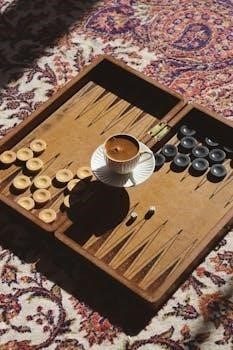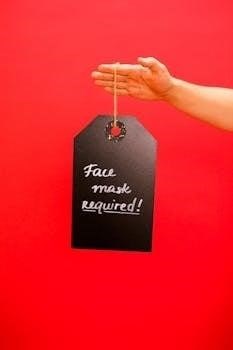Backgammon Board Setup
The backgammon board is divided into four quadrants‚ each containing six narrow triangles‚ called points. These points alternate in color. Players have a home board and an outer board‚ as well as an opponent’s home and outer board.
Components of the Board
The backgammon board consists of twenty-four narrow triangles‚ or points‚ arranged in four quadrants of six points each. These points are typically alternating colors‚ creating a visually distinct playing area. Each player has a home board and an outer board located on opposite sides of the board. There are also two dice‚ used for determining movement‚ and a doubling cube‚ marked with 2‚ 4‚ 8‚ 16‚ 32‚ and 64. The doubling cube is used for raising the stakes during the game. Checkers‚ usually 15 per player‚ in two different colors‚ are also used. Dice cups are optional for shaking dice.
Initial Checker Placement
At the start of a backgammon game‚ each player’s fifteen checkers are placed in a specific configuration on the board. Two checkers are positioned on the 24-point‚ two on the 13-point‚ five on the 8-point‚ and six on the 6-point. This placement is mirrored for both players‚ with each player’s checkers positioned on their respective sides of the board. The players have checkers of opposing colors and start on opposite sides of the board. This initial setup is consistent across all standard games‚ and does not change regardless of who starts first.
Objective of Backgammon
The main goal in backgammon is to move all fifteen of your checkers around the board‚ into your home board‚ and then off the board completely. The first player to do so wins.
Bearing Off Checkers
Bearing off is the final stage of backgammon‚ where you remove your checkers from the board. This can only begin once all of your checkers are in your home board. You roll the dice and remove checkers from points that match the numbers rolled. If there are no checkers on the point corresponding to the die‚ you may move from a higher point. The first player to bear off all their checkers wins the game. If a checker is hit during bearing off‚ it must be re-entered to be bear off again.
Basic Gameplay
Players take turns rolling two dice‚ moving their checkers according to the numbers shown; The goal is to move all checkers into their home board and then bear them off.
Rolling the Dice
At the start of each turn‚ a player rolls two standard six-sided dice. The dice must be rolled together and land flat on the right side of the game board. The numbers rolled dictate how many points a player can move their checkers during their turn. Each die represents an individual move. If doubles are rolled‚ the player makes four moves instead of two‚ using the value shown on the dice. The dice must always be rolled together.
Moving Checkers
Players move their checkers around the board according to the numbers rolled on the dice. Checkers can only move forward to an open point‚ which is a point not occupied by two or more of the opponent’s checkers. A single checker on a point is called a blot and can be hit. A player must move the full amount of the number rolled if it is possible. If one die can be moved‚ but not the other‚ the player MUST move if possible. If both dice can be moved‚ the player can choose the order.
Hitting and Entering Checkers
If a checker lands on a point occupied by only one of the opponent’s checkers‚ the opponent’s checker is “hit” and placed on the bar. A player with checkers on the bar must enter those checkers back into the game on their opponent’s home board‚ using rolls that correspond to an open point. A player cannot move any other checkers until all checkers on the bar have been re-entered. If a player cannot re-enter a checker‚ they lose their turn.

Doubling Cube
The doubling cube is a die marked with 2‚ 4‚ 8‚ 16‚ 32‚ and 64. It’s used to increase the stakes of a game. A player can double when it is their turn.
Using the Doubling Cube
During a game‚ a player who believes they have an advantage can propose to double the stakes by turning the doubling cube to the next higher number. The opponent can either accept the double‚ continuing the game at the new stakes‚ or reject it‚ conceding the current game and losing the previous stake amount. If a player accepts a double‚ they then own the cube and only they can propose the next double. The doubling cube adds a strategic layer to the game.

Scoring
Backgammon is played for an agreed stake per point. Each game starts at one point. The game’s value is determined by the doubling cube and whether a gammon or backgammon occurs.
Gammon and Backgammon
A gammon occurs when a player bears off all checkers before their opponent removes any. This results in the winner receiving double the current stake. A backgammon happens if the loser hasn’t borne off any checkers and still has one or more checkers on the bar or in the winner’s home board‚ resulting in the winner receiving triple the current stake. These outcomes significantly increase the game’s point value and influence strategy. The Jacoby rule can affect the scoring when it comes to gammons and backgammons.

Optional Rules
Several optional rules exist in backgammon‚ enhancing gameplay. The Crawford rule and the Jacoby rule are commonly used variations‚ each adding a unique strategic twist to the game.
Crawford Rule
The Crawford Rule is an optional rule used in match play. If one player reaches a score that is one point away from winning the entire match‚ then the doubling cube cannot be used by either player in the following game. This rule prevents the trailing player from immediately doubling and potentially winning the game‚ adding a strategic layer to match play. After this ‘Crawford game‚’ normal doubling cube rules resume.
Jacoby Rule
The Jacoby Rule is an optional rule that affects the scoring of gammons and backgammons. It states that a gammon or backgammon does not count for extra points unless the doubling cube has been used in the game; This means that if no player has doubled‚ then a gammon or backgammon only counts as a single point. This rule encourages more aggressive doubling strategies during gameplay‚ adding a layer of complexity for experienced players.

Common Mistakes
Players often make errors‚ like neglecting to use the doubling cube strategically or failing to anticipate opponent moves. Avoiding these typical errors can lead to improved gameplay and better results.
Avoiding Typical Errors
Many beginners struggle with common pitfalls in backgammon. One frequent mistake is not planning several moves ahead‚ leading to vulnerable checkers. Another typical error is neglecting the doubling cube‚ missing opportunities to maximize scores. Also‚ players often fail to recognize when a gammon or backgammon is possible‚ and therefore‚ do not play accordingly. Additionally‚ many players underestimate the importance of securing points and blocking their opponent’s checkers. Effective game play requires paying close attention to your own and your opponent’s board positions‚ and playing strategically based on the board conditions.



